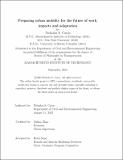Preparing urban mobility for the future of work: impacts and adaptation
Author(s)
Caros, Nicholas S.
DownloadThesis PDF (38.00Mb)
Advisor
Zhao, Jinhua
Terms of use
Metadata
Show full item recordAbstract
The unexpectedly rapid rise of remote work in recent years has upended longstanding travel patterns. Commuting to work is no longer a routine trip with a fixed destination; millions of people have suddenly been granted the flexibility to choose their own work location and travel schedule when working remotely. Urban transportation systems designed and operated to serve regular commuters are struggling to meet the evolving mobility needs of their communities and are facing substantial demand shortfalls as a result. Moreover, there is evidence of a latent desire for new mobility services and land use policies that allow remote workers to take full advantage of the flexibility offered by remote work.
This dissertation takes a three-step approach to addressing the issues presented by remote work through transportation policy. First, it creates the conceptual infrastructure needed to support interdisciplinary remote work research that can be translated into evidence-based policy. This infrastructure includes a common taxonomy of remote work stakeholders and arrangements, a map of the relationships between stakeholders, and a conceptual framework for describing and classifying individual remote work studies. Several examples demonstrate how the taxonomy and framework can be used to develop comprehensive research findings that facilitate the design of remote work policy.
The second step is collecting and analyzing extensive primary data related to remote work arrangements and associated travel behavior. New questions were added to a monthly national survey, allowing the identification of unanticipated aggregate and disaggregate trends. One of the most important findings is that approximately one-third of all remote work takes place outside of the home, at other work-friendly third places such as coffee shops and libraries. Many personal factors are found to be predictive of the choice of work location, including household characteristics such as the presence of roommates, employer remote work policies, and attitudes towards colleagues. An extended example of modeling the commuting frequency, mode choice, departure time, and destination of commutes to third places demonstrates how this rich source of data can be used to inform travel demand modeling for remote workers. These new models, which leverage zero-one inflated beta regression and mobile phone records to predict individual commuting patterns, are then applied to the City of Chicago to estimate the impact of remote work on carbon emissions from commuting. The study finds that overall carbon emissions are reduced by 31% relative to a 2019 baseline, and that commutes to third places are responsible for 16% of all commuting-related emissions.
The third step is applying the insights and predictive models generated from the previously collected data to optimize urban mobility systems for remote work. The studies in this section of the dissertation tackle challenges faced by different remote work stakeholders: shared mobility platforms, public transit agencies, and shared workplace providers. For shared mobility platforms, a new type of ride-pooling service that leverages the destination flexibility of remote workers and other customers is shown to lead to more efficient passenger-vehicle matching and thus reduce vehicle distance traveled. A case study using ride-hailing data from Manhattan estimates that when a quarter of passengers have flexible destinations, overall travel can be reduced by 4.8%.
The matching algorithm also allows shared mobility platforms to cooperate with employers and shared workplace providers to offer an all-inclusive mobility and workplace service. Employer incentives for employees to work at the same location as their team members are found to reduce the efficiency of passenger-vehicle matching and lead to longer trips.
To help public transit agencies respond to remote work, a new transit capacity flexibility model is developed. It allows agencies to evaluate the capacity of the network under different levels of passenger flexibility and changing destination preferences. The capacity flexibility model, which is the first such model that is tractable for network-sized problems, is then solved for the Boston rapid transit system. It demonstrates that the Boston network can accommodate 13% fewer passengers when commuting demand partially shifts from the downtown core to neighborhood centers as a consequence of remote work.
Many governments are exploring opportunities to build new shared workplaces due to substantial interest in working at third places among remote workers. Shared workplaces can also address some of the social issues presented by remote work, such as social isolation and fewer interaction opportunities. The third study in this section proposes an integer programming model for selecting optimal shared workplace sites under social objectives. It finds that the distribution of shared workplaces varies significantly depending on the objective, and proposes a multi-objective framework for generating solutions with a balanced set of social benefits.
To conclude, the potential applications of this research are discussed and an extensive agenda for future remote work and urban mobility research is presented.
Date issued
2023-09Department
Massachusetts Institute of Technology. Department of Civil and Environmental EngineeringPublisher
Massachusetts Institute of Technology